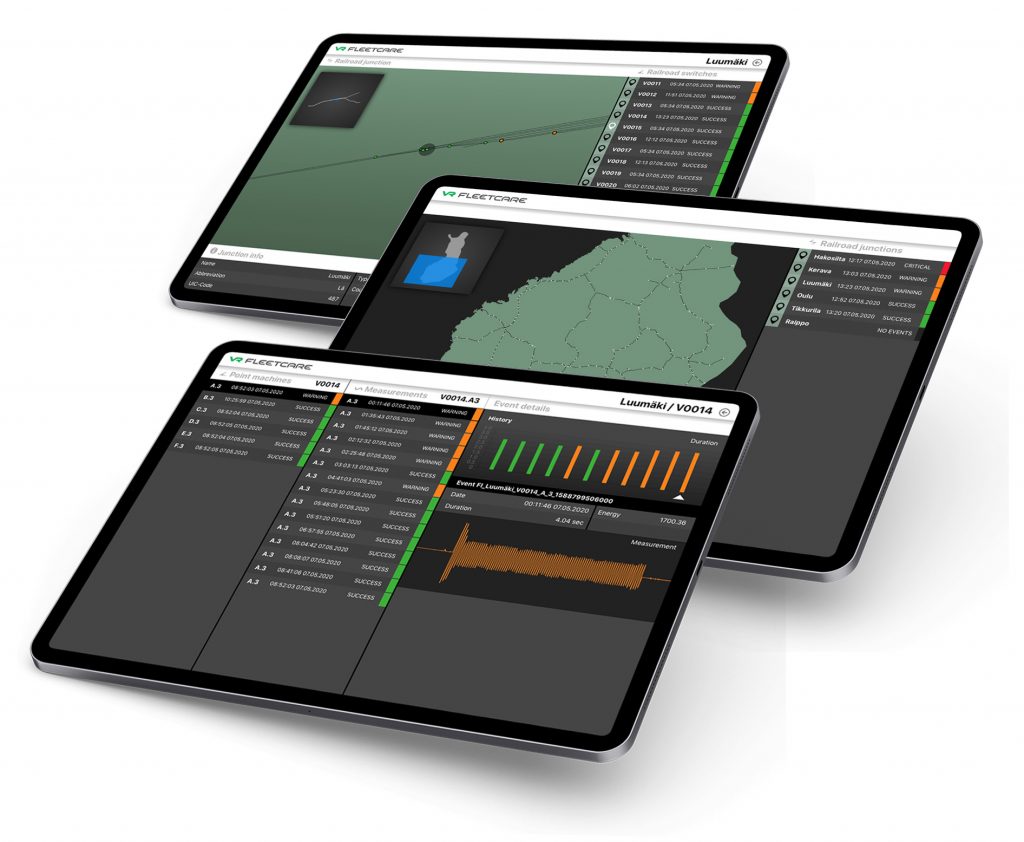VIREBOX - CASE VR fleetcare
Efficiency for the monitoring of railway conditions
VR Fleetcare’s customer, Väylä, had challenges with the reversal of railway switches. Fleetcare’s experts knew what conclusions could be drawn from the power consumption of switches. They understood that it would make sense to connect sensors to each switch to measure the electrical current. However, no one had this kind of system available. According to Mikko Alanko, Sales and Development Director for Digital Services at Fleetcare, the development of such a system would have cost hundreds of thousands of euros. Then someone figured out that it would be a good idea to take a measurement from the interlocking machine. Vire Labs had an almost ready-made solution for this. The price also dropped to tens of thousands.
According to Alanko, the potential of digital services in railway maintenance is tens of millions of euros. The value is generated by improved reliability, dependability, and cost-effectiveness. For example, if a visual inspection of the condition of the equipment can be performed by machine, working hours will only be used in cases where the measurements indicate that there is something deviating. This saves labour costs, but also makes inspections more accurate. It improves safety.

The benefits of digitalization are in improving the efficiency of processes
Mikko Alanko, VR Fleetcare
“Technology is no longer a problem. You can measure almost everything. The challenge is to prove what the benefits of technology are and what kind of processes can be measured out,” says Alanko.
The process development at Fleetcare is still ahead of us. For example, information from the preventive maintenance system of switches and crossings must be integrated into Fleetcare’s normal maintenance process. “Where we have previously received fault reports made by people, in the future the fault reports will be made on the basis of information from the system,” Alanko describes.
“This changes the work of our maintenance planners: they learn to read through the system what, when, and where repairs are needed. We have a lot of people who are excited about the opportunity to get new tools, because they understand the benefits they bring. When they buy an idea, they quickly get involved in developing and brainstorming where data would be useful. Of course, some people also experience fears about whether the system will deprive them of their work. The most important part of digitalizing operations is therefore managing change,” says Alanko.

Same product, different sensors and measurement techniques
In addition to switches and crossings, there are a lot of stationary objects on the tracks, such as level crossings. They can be monitored with the same product by connecting to a different sensor. Instead of measuring electrical current, Virebox.AI can measure other variables or produce an image with a high-speed camera or laser scanning. According to Alanko, “in the railway environment, it is very useful that the analysis is done by a measuring device such as Virebox.AI, because when the equipment is moving, data transmission has difficulty keeping up. Then edge computing is the only option. The accuracy requirements for measuring data are constantly increasing. The more you measure, the more data you accumulate, the more important edge computing is,” Alanko sums up. “Besides, if you can control edge computing devices centrally like you do here, it’s really modern,” he says.
A solution-oriented approach is important in partnership
According to Alanko, “collaboration was started with Vire Labs due to Vire Labs’ strong commitment to development work. Collaboration has been very easy. We have focused together on solving things and thus have been able to solve problems before they grew into conflicts.”
Alanko sees great potential in collaboration. “Digitalization is moving forward at a fast pace. We have a scalable product here that we can use for many things,” he sums up.